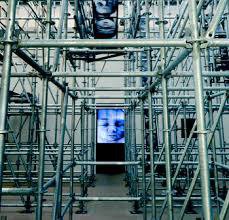Christian Boltanski
dal 8/1/2014 al 22/3/2014
Segnalato da
8/1/2014
Christian Boltanski
Carriageworks, Eveleigh
Chance. Resembling a giant newspaper printing press over 40 metres long and eight metres high, Wheel of Fortune is built with 20 tonnes of scaffolding and has a moving reel of photographs within it. Responding to the architecture and scale of Carriageworks this immense and complex installation allows to witness lives unfold, following the rhythm of births and deaths across the globe. Boltanski invites to explore the idea that all human life is the result of chance.

"We are a puzzle of all the people living before us: the chin of a grandfather and the eyes of a great-great uncle and the ears of a great-great grandmother."
—Christian Boltanski
Christian Boltanski is acknowledged internationally as one of the most important artists of his generation. For over five decades he has made work that explores the unpredictable turns of life through the themes of memory, birth and death.
Chance is an immense and complex installation comprised of three works; Wheel of Fortune, Last News From Humans, and Be New. Responding to the architecture and scale of Carriageworks, Boltanski invites visitors to interact with the work as they follow the rhythm of births and deaths across the globe. While the artist explores the idea that all human life is the result of chance, his work reminds us of our mortality, and ultimately affirms the continuum of life.
Resembling a giant newspaper printing press over 40 metres long and eight metres high, Wheel of Fortune is built with 20 tonnes of scaffolding and has a moving reel of photographs within it. These photos are the faces of newborn babies, gleaned from the birth announcement pages of Polish newspapers. Tightly cropped and printed in black and white, their faces are timeless, anonymous yet individual. At intervals throughout the day, a bell rings and the images come to a stop, a camera capturing one child’s face which is displayed on a screen.
Bookending Wheel of Fortune are two scaffold towers that form Last News From Humans. Operating 24 hours a day the digital counters tally in real-time births and deaths around the globe. The green counters represent the number of births, and the red counters indicate the number of deaths. Their rapid turnover signifies the speed in which lives both begin and end. On average each day there are 200,000 more people born than those who die.
Fascinated with the association between authenticity and photography, Boltanski often uses existing photos of people within his work. In Be New the faces of sixty Polish newborns and fifty-two deceased Swiss are cut into three parts, of which there are potentially 1.5 million combinations. Be New invites the viewer to stop the computer program and produce a new human face. The work is a reminder that we are all a composite of those who have preceded us.
Originally commissioned by the Institut Français for the French Pavilion for the 54th Venice Biennale in 2011, Chance has been reconfigured for presentation at Carriageworks. In 2012 Chance was exhibited at the Nederlands Fotomusuem, in Rotterdam, The Netherlands, and in Rio de Janeiro at the Casa França Brasil. In 2014 Chance is presented by Carriageworks in association with Sydney Festival.
Public program
Christian Boltanski in conversation with Dr. Andrew Frost
Thursday 9 January, 6pm - WAIT LIST FULL
About Carriageworks
Carriageworks produces and presents a contemporary multi-arts program that explores contemporary ideas and issues. The Carriageworks Artistic Program is ambitious, risk-taking and provides significant support to leading Australian and international artists through producing contemporary work. Carriageworks is a cultural facility of the NSW Government and is supported by Arts NSW. The Carriageworks program can be viewed at carriageworks.com.au.
Image: Christian Boltanski, "Chance," 2011. Installation view, Pavillon français,
Venice Biennale, 2011. Photo: Didier Plowy. Coproduction: Institut français /
Centre national des arts plastiques.
Carriageworks
245 Wilson Street - Eveleigh



